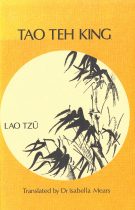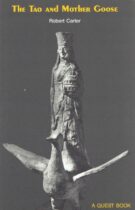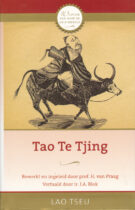Het Geluk van TAO – Verhalen en Parabels uit China
Door Erich en Leo Kaniok.
140 Pagina’s | Eerste & tweede druk 2008, derde druk 2010 | Hardcover | Asoka, een imprint van Milinda Uitgevers, Geraardsbergen | ISBN: 9789056701925.
‘In de wereld van de kennis voegt men elke dag iets toe. In de wereld van de TAO laat men iedere dag iets los’.
Deze uitspraak van Lao Tse is nu misschien wel actueler dan ooit. In onze huidige samenleving zijn we bezeten van vooruitgang. Wat het leven je ook heeft gebracht, het is nooit genoeg. We willen altijd iets anders of meer, dan dat we nu hebben. We denken dat onze bestemming voor ons ligt en we er hard voor moeten werken om die te bereiken. Niet steeds meer willen bereiken, maar de diepte van elke moment ervaren, daarin ligt de TAO verborgen.
De verhalen in dit boek helpen bij de herkenning dat er geluk ligt in elke handeling die je uitvoert, en niet alleen in het resultaat van die handeling. Dit is de kracht van TAO, de schoonheid van een weg, die tevens het doel is.
Afkomstig van p. 80 – ‘Zijn zonder Titel’:
” Op een dag kwam de gouverneur van Lu voor het eerst op bezoek bij Lao Tse. Een van zijn leerlingen liet Lao Tse het visitekaartje van de gouverneur zien waarop stond: ‘Kitagaki, Gouverneur van Lu’. ‘Met zo’n man wil ik niets te maken hebben’, zel Lao Tse tegen zijn leerling. ‘Zeg maar tegen hem dat hij rechtsomkeert maakt’. De leerling bracht het kaartje terug en verontschuldigde zich. ‘O nee, het was mijn fout’, zei de gouverneur en met een potlood kraste hij de woorden ‘Gouverneur van Lu’ door. ‘Breng het alstublieft nog een keer naar uw leraar’. Toen Lao Tse het kaartje zag, riep hij uit: ‘O, is dat Kitagaki? Breng hem binnen, ik wil hem graag ontmoeten. “
Inleiding Taoïstische Filosofie – Leven vanuit Niet-Doen
Door Michel Dijkstra (red.), Rene Ransdorp, Jan De Meyer en Woei-Lien Chong.
184 Pagina’s | Tweede druk 2015 | Softcover | ISVW Uitgevers, Leusden | ISBN: 9789491693526.
De Daodejing van Laozi, de belangrijkste tekst van de taoïstische filosofie, is wellicht het meest vertaalde geschrift ter wereld op de Bijbel na. Een centraal begrip in dit mysterieuze boek is wuwei (‘niet-doen’). Dit idee houdt niet in dat je moet niksen in het leven, maar dat je niets afdwingt.
Deze gedachte komen we ook tegen bij Zhuangzi en Liezi, twee andere kopstukken van de taoïstische filosofie. Alleen als je open staat voor elke situatie en alles in zijn waarde laat, zul je ontspannen en vol vreugde je doel bereiken. Deze houding vereist wuxin (‘het zonder hart zijn’), ook te vertalen als ‘de lege geest’ of ‘het lege hart’. In deze inleiding worden de belangrijkste filosofische uitgangspunten van het taoïsme belicht. Daarbij komt een keur aan onderwerpen aan bod, zoals politieke filosofie, kennistheorie, het mensbeeld, als ook de invloed op het zenboeddhisme en parallellen met het Westerse denken.
Afkomstig uit Hoofdstuk 3 – ‘Zhuangzi en Wuwei: Handelen vanuit het Innerlijke Centrum’ (p. 107):
” Concentreer al je aandacht. Luister niet meer met je oren, maar luister met je hart. Luister niet meer met je hart maar luister met je qi. Luisteren houdt op bij de oren, het hart komt niet verder dan symbolen. Maar qi is leeg en laat daardoor alle dingen zijn, Dao concentreert zich alleen daar waar leegte is. Leeg zijn, dat is waar het vasten van het hart op neerkomt. “
TAO – De Levende Religie van China
Door Lao Tzu (601 BC – unknown), commentaar door Kristofer Schipper.
317 Bladzijden | Eerste druk 1988, 9de druk 2009 | Softcover | J.M. Meulenhoff Uitgeverij | ISBN:
In TAO beschrijft Kristofer Schipper in heldere taal de geschiedenis van de Chinese Leer. Hij verdiept zich in de rituelen, die erbij horen en de elementen, waaruit de leer is opgebouwd, zoals de grote aandacht voor het mensenlijk lichaam en de kosmologie. Tao is zowel een uitstekende inleiding voor buitenstaanders als waardevol studiemateriaal voor wie al meer vertrouwd is met de leer. Tao is veel meer dan een godsdienst, het is een manier van kijken en een manier van in het leven staan. Een religie zonder gelovigen en zonder canonieke leerstellingen.
Het boek biedt meerwaarde voor iedereen, die meer over China te weten wilt komen. In alles wat in de afgelopen eeuw in dit machtige rijk is voorgevallen, zowel onder het maoïsme als tijdens de gigantische industrialisatie, heeft de Tao bewust of onbewust doorgewerkt.
Kristofer Schipper was hoogleraar aan de Leidse Universiteit en aan de École Pratique des Hautes Études in Parijs en is opgeleid tot taoïstisch meester.
The Guiding Light of Lao Tzu
By Lao Tse (601 BC – unknown), translated by Henry Wei.
234 Pages | First published 1982, 3rd printing 1988 | Paperback | Quest Books, U.S.A. | ISBN:
Twenty-six centuries ago, a man called Lao Tzu offered a daringly new way of life to his countrymen. His work is called the TAO Teh Ching, a philosophy of pure beauty, rare charm, and great spiritual depth and represents a magnificent treatise on human rights. For centuries, it has been a source of inspiration for Chinese art, poetry and painting. In many of its moral viewpoints it is similar to Christianity. Indirectly, it also inspired the development of acupuncture, alchemy, astrology, and the martial arts (kung fu). Its quintessential teaching, however concerns yoga and meditation.
About the ‘Eternal Tao’ (p.22):
” There is something formless and perfect,
Existing before the birth of Heaven and Earth
How still it is! How quiet!
Abiding alone and unchanging,
It pervades everywhere without fail.
Well may it be called Mother of the World.
I do not know its name,
but label it TAO . . . “
The TAO-Teh-King – Sayings of Lao Tszu
By Lao Tse (601 BC – unknown), translated by C. Spurgeon Medhurst.
165 Pages | Original edition 1905, 2nd Quest book printing 1975 | Softcover | Quest Books, U.S.A. | ISBN: 0835604306.
One of the great sages of history was a man named Lao Tzu, who was born in China in the year 604 B.C. He is regarded as the founder of the system of religion known as Taoism. His writings have been preserved in a small volume of poetry entitled Tao-Teh-King, which translated means ‘The Way and Its Power’, or ‘The Book of the Way and its Virtue’. It has also been called ‘A Scripture of the Eternal and Its Characteristics’, and it was adopted as a canon in the year 666 A.D. during the rule of the Emperor Kao Tsung of the T’ang Dynasty. Because of its sublime and timeless concepts, the Tao-Teh-King has endured through the centuries; it has been translated into many languages, and has been the subject of numerous volumes of philosophical and speculative literature.\
From Chapter 4 (p. 27):
” The TAO is as emptiness, so are its operations. It resembles non-fullness.
Fathomless! It seems to be the ancestor of all form. It removes sharpness, unravels confusion, harmonizes brightness, and becomes one with everything.
Pellucid! It bears the appearance of permanence. I know not whose son it is. Its Noumenon (εἴδωλον) was before the Lord. “
TAO Teh King – A Tentative Translation from the Chinese
Door Lao Tse (601 BC – unknown), vertaald door Dr. Isabella Meers.
105 Pages | First edition 1922, 3rd reprint 1983 | Softcover | Theosophical Publishing House, Adyar | ISBN: 0722903006.
The name ‘Lao Tsu’ means ‘old young’, so that on the very threshold of our study we find a paradox, and we may call the wonderful teacher ’the old philosopher’, ’the old child’ or ’the young old man’. His family surname was Li. He wrote this book Tao Teh King, a book around which cluster much speculation and much literature in Chinese and other languages. The word ‘King’ we may leave out of count as it simply means classic, and was not given by Lao Tzu himself, but was added much later as a mark of respect.
From chapter XLVII (p. 67):
” Without going out of my door
I know the Universe
Without opening my window
I perceive Heavenly Tao
The more I go abroad, the less I understand
That is why the self-controlled man
arrives without going
names things without seeing them,
perfects without activity. “
The Secret of the Golden Flower – A Chinese Book of Life
Translated and explained by Richard Wilhelm (1873 – 1930), with a commentary by Carl Gustav Jung (1875 – 1961)
149 Pages | First published in 1931; new, revised & augmented edition, 1962 | Softcover | Harcourt Brace & Company, USA | ISBN 9780156799805
The Secret of the Golden Flower, the Treatise that forms the central part of this book, was discovered by Professor Wilhelm, who recognized it as essentially a practical guide to the integration of the personality. His German translation, published in the autumn of 1929 shortly before his death, was immediately hailed by Jung as a link between the insights of the East and his own psychological research, a relationship explored by the great analytical psychologist in a brilliant and significant commentary.
This edition also contains part of another Chinese meditation text, the Hui Ming Ching or The Book of Consciousness and Life, and is illustrated with numerous plates and drawings.
A quotation about ‘detachment’ (p. 122):
A halo of light surrounds the world of the law.
We forget one another, quiet and pure, altogether powerful and empty.
The emptiness is irradiated by the light of the heart of heaven.
The water of the sea is smooth and mirrors the moon its surface.
The clouds disappear in blue space; the mountains shine clear.
Consciousness reverts to contemplation; the moondisk rests alone.
From the Hui Ming Ching
The Tao and Mother Goose
By Robert Carter.
186 Pages | A Quest Original, first edition 1988 | Softcover | Quest Books, U.S.A. | ISBN: 0835606317.
Art instructor Robert Carter’s illustrated book is both enjoyable and informative, written in an engaging style. Rhymes of Mother Goose, he suggests, frequently are spiritual parables. He compares many of the famous aphorisms from Lao Tsu’s Tao Teh Ching. noting similarities of viewpoints. Carter feels that teachings of the Chinese philosopher and even Mother Goose nursery rhymes are addressed to some deeper level within each one of us. Consequently, a simple word, phrase, or idea in this meditative picture book might spark something deep within the reader.
From ‘Chapter III – Mother Goose’ (p. 51):
” In Greece, of course, it was Aphrodite herself, who rode on the goose. Aphrodite was Goddess of love and beauty, among many other things, and filled the creative function of The Great Goddess, in that she symbolized the fertile and regenerative powers of nature, like the goose, in three realms: on land, in the sea and in the air. She was a female ruling principle of Nature. And from the illustration we can imagine that she might almost be the one being described in the rhyme:
Old Mother Goose, when
She wanted to wander,
Would ride through the air
On a very fine Gander. “
TAO Te Tjing
Door Lao Tse (601 BC – unknown), bewerkt en ingeleid door Prof. H. van Praag, vertaald door J.A. Blok.
159 Pagina’s | Eerste druk 1910, 13de herziene druk 2013 (Klassiekers) | Softcover | Ankh-Hermes BV., Utrecht | ISBN: 9789020209952.
Het boek Tao Te Tjing is een van de belangrijkste geschriften van het Taoïsme. Centraal staan ‘het volgen van het Tao’ en ‘woe-wei’, het niet ingrijpen, het loslaten dat wil zeggen, je niet verzetten tegen de loop der dingen, maar daar spontaan in meegaan. De Tao Te Tjing is een Wijsheidsboek, dat door zijn diepgang en oorspronkelijkheid wordt gerekend tot de hoogtepunten van de wereldliteratuur. Het werk wordt toegeschreven aan Lao Tse, een oudere tijdgenoot van Confucius (551 – 479 v. Chr.).
Uit Hoofdstuk 8 zoals vermeld in de Inleiding (p. 33):
” Het hoogste goed is als water.
Water doet alle wezens goed en strijdt niet.
Het woont op plaatsen door alle mensen veracht.
Daarin komt het goede Tao nabij.
Hij leeft gaarne op lage plaatsen.
Zijn hart houdt van de diepte.
In weldoen houdt hij van de liefde,
in spreken van de waarheid,
in bestuur van de orde,
in werken van bekwaamheid,
in handelen van de geschikte tijd.
Hij strijdt niet, daardoor treft hem geen blaam. “
 Bezig met bijwerken…
Bezig met bijwerken…







